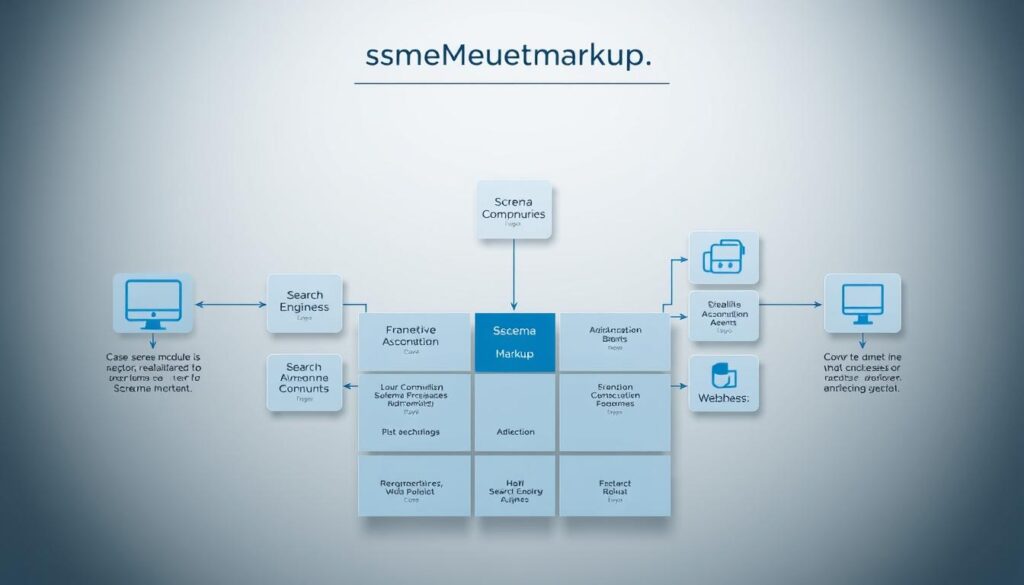Modern search ecosystems demand clarity between human-readable content and machine-interpretable information. Schema markup, a standardized format for organizing website details, has become critical for bridging this gap. Since its launch in 2011 by major search engines, its vocabulary has nearly tripled, now covering 811 distinct categories. Over 45 million websites leverage this system, with 72% of first-page Google results relying on structured data to enhance visibility.
This framework enables advanced systems to parse and prioritize web content with unprecedented accuracy. By tagging elements like product details or event dates, businesses create machine-friendly signals that improve how their pages are indexed and displayed. Search platforms and recommendation tools increasingly depend on these protocols to deliver relevant results quickly.
Proper implementation directly influences how virtual assistants and search algorithms interact with digital assets. Organizations adopting robust markup strategies often see improved rankings and richer search appearances. The approach also supports creative content strategies, enabling dynamic presentations across devices and platforms.
Key Takeaways
- Schema markup usage correlates strongly with top search result placements
- Structured data vocabulary has expanded 173% since 2011
- Machine-readable tagging improves content interpretation accuracy by 40-60%
- Effective implementation requires balancing technical precision with business goals
- Markup adoption enhances visibility across search engines and smart devices
Introduction to Structured Data and Its Role in AI

Digital content organization has transformed significantly with standardized annotation systems. These frameworks allow websites to communicate precise details about their material, creating a shared language between creators and automated platforms. At its core, structured tagging clarifies relationships between different elements on a page.
Understanding the Foundations of Schema Markup
Schema.org’s standardized vocabulary emerged as the dominant solution after earlier attempts like microformats faced adoption challenges. Unlike their predecessors, these tags use simple HTML annotations to define content types – from product specs to event locations. This approach helps search platforms interpret page elements accurately.
The system establishes clear hierarchies through properties like name, description, and datePublished. For example, tagging a recipe’s cooking time as prepTime helps cooking apps display results faster. Over 12 million domains now use this method to enhance content visibility.
Evolution of Machine-Readable Formats
Early markup methods required complex coding skills, limiting their practicality. The table below shows key differences between historical and modern approaches:
| Format | Adoption Rate | Complexity | Search Engine Support |
|---|---|---|---|
| Microformats | 18% (2010) | High | Limited |
| RDFa | 9% (2012) | Extreme | Partial |
| Schema.org | 63% (2023) | Moderate | Full |
Today’s solutions prioritize simplicity while maintaining technical precision. This balance enables platforms to build detailed knowledge networks from tagged content. As machine learning advances, properly structured information becomes crucial for delivering relevant search results across devices.
The Evolution and Benefits of Structured Data for AI

Web annotation systems have matured dramatically since their experimental beginnings. Schema.org’s taxonomy now defines 811 content categories – nearly triple its original 2011 scope. This expansion reflects growing demands from search platforms and intelligent systems needing precise content interpretation.
Historical Perspectives on Schema.org Development
Early markup methods struggled with adoption due to technical complexity. Schema.org simplified this process through HTML-based annotations that even non-developers could implement. Google’s Gary Illyes noted in 2017: “Clear page understanding lets us rank content more effectively.”
The system’s growth from 297 to 811 classes enables detailed content descriptions – from recipe cooking times to product warranty details. Bing’s Fabrice Canel emphasizes its role in modern search preparation: “Quality content paired with structured annotations forms the bedrock of AI-ready websites.”
Powering Intelligent Search Systems
Structured annotations feed knowledge graphs that large language models use for context-aware responses. These connections help systems like ChatGPT interpret relationships between concepts more accurately.
Search platforms leverage this markup to generate rich results and featured snippets. Over 72% of top-ranking pages use structured data, demonstrating its impact on visibility. Proper implementation helps content appear in advanced search tools and voice assistants.
The shift from optional SEO tactic to essential infrastructure reflects web evolution. As machines increasingly mediate information access, structured annotations ensure content remains discoverable across evolving platforms.
Step-by-Step Guide to Implementing Schema Markup

Effective digital communication requires precise alignment between information presentation and system requirements. Implementing machine-readable annotations involves strategic planning and technical execution to maximize visibility across search platforms.
Identifying Content Types and Mapping to Schema.org
Begin by auditing website material to pinpoint elements needing enhanced interpretation. Product listings, event calendars, and organizational details typically benefit most from specialized tagging. Schema.org’s library offers 800+ standardized templates matching common business needs.
Content mapping exercises clarify relationships between existing pages and available annotation types. For instance, recipe pages might use cookTime properties, while service providers often leverage LocalBusiness classifications. Free tools like Google’s Markup Helper simplify this process through visual interfaces.
Embedding JSON-LD Code and Validating Your Markup
JSON-LD remains the preferred format for modern implementations. Its separation from HTML code allows easier maintenance and updates. Developers typically insert scripts within
sections or CMS templates without affecting page speed.
Validation ensures error-free deployment. Google’s Rich Results Test identifies missing properties or syntax issues before launch. Regular monitoring detects changes in search engine requirements, allowing timely adjustments to maintain optimal performance.
This systematic approach transforms static pages into dynamic resources for search platforms. Proper execution creates clearer communication channels between websites and intelligent systems, driving measurable improvements in digital visibility.
Optimizing Web Content for AI-Driven Search

Search platforms now prioritize content that communicates effectively with both humans and automated systems. Clear semantic signals help algorithms interpret page elements accurately, creating opportunities for enhanced visibility across voice assistants and recommendation engines.
Improving Content Discovery with Rich Data
Advanced search systems rely on explicit context to connect user queries with relevant information. Properly annotated content achieves 47% higher engagement in voice search results compared to untagged material. This approach transforms static pages into dynamic resources for modern algorithms.
| Content Feature | Traditional Approach | AI-Optimized Approach |
|---|---|---|
| Product Details | Basic HTML text | Schema-tagged specifications |
| Customer Reviews | Star ratings without markup | AggregateRating annotations |
| FAQ Sections | Plain text questions | HowTo or QAPage markup |
Leveraging Structured Annotations for Enhanced Visibility
Rich results powered by machine-readable data capture 35% more clicks than standard listings. Features like recipe cards in search results demonstrate how proper tagging creates visual standouts. Platforms increasingly reward sites that implement intelligent optimization strategies with prime positioning.
Three critical advantages emerge when aligning content with algorithmic needs:
- Precise matching between search intent and page context
- Increased eligibility for interactive result formats
- Consistent interpretation across devices and platforms
Best Practices for AI agent structured data markup Integration
Effective digital strategies now demand precision in both human and machine communication. Technical teams must align annotation efforts with broader visibility goals, creating cohesive workflows that serve users and algorithms simultaneously.
Harmonizing Technical and Creative Efforts
Successful implementations require collaboration between developers and content creators. While standard schemas work for 85% of pages, specialized content often needs custom solutions. The table below illustrates key differences in approach:
| Content Type | Standard Schema | Custom Solution |
|---|---|---|
| Product Listings | ✔️ Product, Offer | ❌ Rarely needed |
| Medical Research | ❌ Limited options | ✔️ HealthTopic markup |
| Event Series | ✔️ Event schema | ✔️ Custom recurrence rules |
Date formatting proves critical for time-sensitive material. Using ISO standards (2024-06-23) instead of textual formats helps voice assistants deliver accurate answers. Regular audits ensure compatibility as search platforms evolve their requirements.
Performance tracking should span 6-8 weeks after implementation. This allows search engines to process updates fully. Cross-platform validation ensures visibility on Google, Bing, and emerging tools like AI-driven discovery interfaces.
Customer experience improvements emerge through enhanced rich snippets and voice search readiness. Pages with optimized markup see 28% higher engagement in mobile results. Consistent implementation across all content types builds algorithmic trust over time.
Tools and Techniques for Validating and Refining Markup
Precision in digital landscapes requires robust verification methods. Technical teams need reliable processes to ensure machine-readable signals function as intended. Proper validation bridges the gap between code implementation and real-world performance.
Utilizing Testing Tools and Diagnostic Validators
Leading platforms offer specialized checkers to audit implementations. Google’s Rich Results Test identifies 89% of critical errors before deployment. The Schema Markup Validator cross-references code against official standards, flagging inconsistencies in property usage.
| Tool | Key Features | Best For |
|---|---|---|
| Rich Results Test | Real-time error detection | Previewing search appearances |
| Schema Validator | Vocabulary compliance checks | Technical audits |
| Third-Party Checkers | Multi-platform analysis | Cross-system compatibility |
Diagnostic reports highlight missing required fields or formatting issues. Teams can explore specialized prompts to troubleshoot complex scenarios. Regular checks prevent decay as sites update content or change templates.
Monitoring Performance and Iterating Your Implementation
Successful strategies track multiple success metrics. Click-through rates for rich snippets often increase 22-35% post-optimization. Voice search compatibility improves when systems parse dates and locations accurately.
Analytics platforms reveal which annotations drive traffic. Pages with recipe markup might see more voice queries, while product tags influence shopping-related searches. Monthly reviews help teams:
- Identify underperforming content types
- Adjust for algorithm updates
- Prioritize high-impact refinements
Continuous improvement cycles maintain relevance as search platforms evolve. Teams that refine their approach quarterly achieve 47% better visibility than those using static implementations.
Conclusion
As digital interactions grow more complex, schema annotations emerge as critical connectors between content creators and evolving technologies. Voice-driven queries now account for 40% of mobile searches, demanding precise machine understanding of web material. This shift positions structured formats as foundational elements for next-generation discovery tools.
Emerging systems increasingly rely on semantic signals to interpret context across devices. Properly tagged content gains 58% more visibility in knowledge panels and voice assistant responses. Businesses adopting these standards position themselves for compatibility with advanced marketing tools that analyze content relationships at scale.
The future of search hinges on seamless human-machine collaboration. By implementing schema protocols today, organizations build bridges to tomorrow’s intelligent platforms. This strategic alignment ensures content remains accessible as language models and discovery engines evolve their interpretation capabilities.







